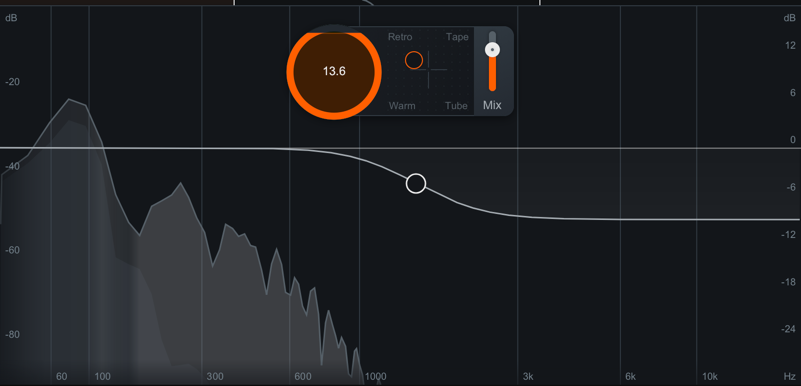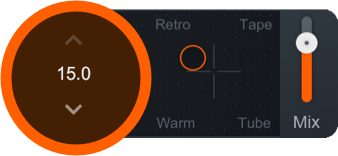Exciter
Overview
The Exciter can be used to add harmonic distortion to enhance and accentuate elements in your audio.
Module Interface

Neutron 3 Exciter module controls and features are outlined in the table below.
| Label | Section | Controls and Features |
|---|---|---|

|
Meters and Displays | Spectrum Displays |

|
Module Header | Multiband Crossover Spectrum View. Pre-Emphasis Modes, Learn, Reset, LFE |

|
Controls | Post Filter, HUD Controls, Drive, X/Y Pad, Mix |
Meters & Displays
Meters and displays illustrate how the Exciter is responding to and processing the input signal. The image below shows the Spectrum Displays.

Spectrum Displays
- Spectrum Analyzer: displays the magnitude (amplitude vs db) of the input and output signals across the
frequency spectrum in real-time.
- Input signal spectrum displays a dark grey spectrum behind the output.
- Output signal spectrum: displays a light grey spectrum, in front of the input signal.
- Northern Lights: Displays highlighted areas of the spectrum to indicate where saturation is applied.
Module Header

| Label | Section |
|---|---|

|
Multiband Crossover Spectrum View |

|
Pre-Emphasis Modes |

|
Learn |

|
Reset |
Multiband Crossover Spectrum View
Access the Multiband Crossover Spectrum View and controls. For more information, see the Multiband Crossover Spectrum View section.
Pre-Emphasis Modes
Use to apply apply subtle harmonic emphasis to saturation in different areas of the frequency spectrum. These differences allow mild changes to the low-mids (vocal thickness or body) or high-mids (vocal presence). The types of Pre-Emphasis Modes available to you are:
- FULL: low-mid frequency bump
- DEFINED: high-mid frequency bump
- CLEAR: gentle, low-mid frequency attenuation
Learn
Enable Learn to allow the Exciter to quickly identify natural crossover cutoff points and provide cutoff placement suggestions based on intelligently identified minima in the spectrum.
Reset
Enable Reset to revert the entire Exciter module back to factory default. If you wish to return to settings you were using before clicking the Reset button, you can use the Undo History window to revert to the settings before the Reset event.
LFE
Appears when in surround sound configuration in a Neutron 3 Advanced mothership. Enabled by default to include LFE in processing. Disable the LFE button to exclude low frequencies when passing audio through the Low Frequency Effects (LFE) channel with the relative latency compensation. See the LFE section for more information.
Controls
Post Filter
Applies gentle shelving for attenuation. Displayed as a high shelf icon as high shelf icon overlaid on the multiband spectrum view.
| Post Filter Adjustments | Ranges |
|---|---|
| Maximum Attenuation | -12dB |
| Frequency Range | 1kHz to 20kHz |
Drag the Post Filter node to adjust the frequency and the gain of the filter.

NOTE: Post Filter Applied to Wet Signal
The Post Filter will affect the entire wet signal which can help adjust/attenuate/tame the Exciter Module’s high end frequency response.
HUD Controls
The following controls are available in the Exciter module HUD:

Drive
Adjust to control the amount of excitation applied to the signal.
X/Y Pad
Blends different harmonic profiles to achieve the sound you want to hear. By moving the node on the pad, you can get a mix of the four profiles as described in the table below.
| Profiles | Description |
|---|---|
| RETRO | Edgy, biting, transistor-based fuzz with a slow decay of odd harmonics. |
| TAPE | Bright, emphasis on odd harmonics without adding damaging artifacts. |
| TUBE | Clear tonal excitation with emphasis on dynamics and transient attacks with a less harsh result than Tape or Retro. |
| WARM | Similar to Tube, but with quickly decaying even harmonics that add color and character. |
Mix
Adjusts how much of the wet (processed) signal is applied to the dry (unprocessed) signal. The processing on the signal is dictated by the X/Y pad settings. Using the mix slider for a different blend of signals can have varying results:
- For a more extreme effect: set the blend to the maximum amount.
- For less distinct and more integrated effect: set the blend to the middle of the slider or lower.